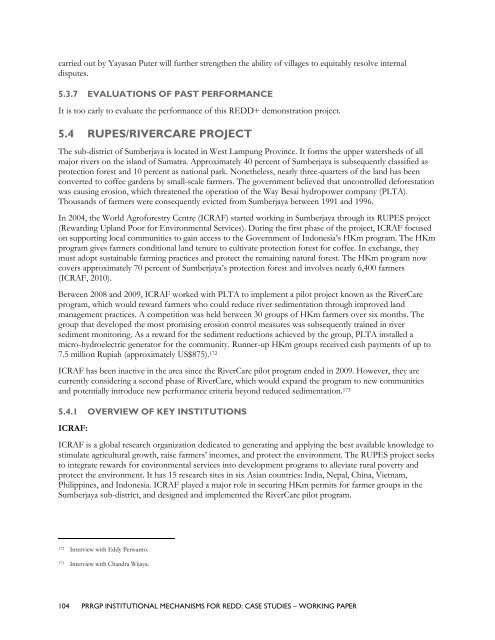Institutional Mechanisms for REDD+ - Case Studies Working Paper
Institutional Mechanisms for REDD+ - Case Studies Working Paper
Institutional Mechanisms for REDD+ - Case Studies Working Paper
Create successful ePaper yourself
Turn your PDF publications into a flip-book with our unique Google optimized e-Paper software.
carried out by Yayasan Puter will further strengthen the ability of villages to equitably resolve internal<br />
disputes.<br />
5.3.7 EVALUATIONS OF PAST PERFORMANCE<br />
It is too early to evaluate the per<strong>for</strong>mance of this <strong>REDD+</strong> demonstration project.<br />
5.4 RUPES/RIVERCARE PROJECT<br />
The sub-district of Sumberjaya is located in West Lampung Province. It <strong>for</strong>ms the upper watersheds of all<br />
major rivers on the island of Sumatra. Approximately 40 percent of Sumberjaya is subsequently classified as<br />
protection <strong>for</strong>est and 10 percent as national park. Nonetheless, nearly three-quarters of the land has been<br />
converted to coffee gardens by small-scale farmers. The government believed that uncontrolled de<strong>for</strong>estation<br />
was causing erosion, which threatened the operation of the Way Besai hydropower company (PLTA).<br />
Thousands of farmers were consequently evicted from Sumberjaya between 1991 and 1996.<br />
In 2004, the World Agro<strong>for</strong>estry Centre (ICRAF) started working in Sumberjaya through its RUPES project<br />
(Rewarding Upland Poor <strong>for</strong> Environmental Services). During the first phase of the project, ICRAF focused<br />
on supporting local communities to gain access to the Government of Indonesia‘s HKm program. The HKm<br />
program gives farmers conditional land tenure to cultivate protection <strong>for</strong>est <strong>for</strong> coffee. In exchange, they<br />
must adopt sustainable farming practices and protect the remaining natural <strong>for</strong>est. The HKm program now<br />
covers approximately 70 percent of Sumberjaya‘s protection <strong>for</strong>est and involves nearly 6,400 farmers<br />
(ICRAF, 2010).<br />
Between 2008 and 2009, ICRAF worked with PLTA to implement a pilot project known as the RiverCare<br />
program, which would reward farmers who could reduce river sedimentation through improved land<br />
management practices. A competition was held between 30 groups of HKm farmers over six months. The<br />
group that developed the most promising erosion control measures was subsequently trained in river<br />
sediment monitoring. As a reward <strong>for</strong> the sediment reductions achieved by the group, PLTA installed a<br />
micro-hydroelectric generator <strong>for</strong> the community. Runner-up HKm groups received cash payments of up to<br />
7.5 million Rupiah (approximately US$875). 172<br />
ICRAF has been inactive in the area since the RiverCare pilot program ended in 2009. However, they are<br />
currently considering a second phase of RiverCare, which would expand the program to new communities<br />
and potentially introduce new per<strong>for</strong>mance criteria beyond reduced sedimentation. 173<br />
5.4.1 OVERVIEW OF KEY INSTITUTIONS<br />
ICRAF:<br />
ICRAF is a global research organization dedicated to generating and applying the best available knowledge to<br />
stimulate agricultural growth, raise farmers‘ incomes, and protect the environment. The RUPES project seeks<br />
to integrate rewards <strong>for</strong> environmental services into development programs to alleviate rural poverty and<br />
protect the environment. It has 15 research sites in six Asian countries: India, Nepal, China, Vietnam,<br />
Philippines, and Indonesia. ICRAF played a major role in securing HKm permits <strong>for</strong> farmer groups in the<br />
Sumberjaya sub-district, and designed and implemented the RiverCare pilot program.<br />
172 Interview with Eddy Perwanto.<br />
173 Interview with Chandra Wijaya.<br />
104 PRRGP INSTITUTIONAL MECHANISMS FOR REDD: CASE STUDIES – WORKING PAPER

















